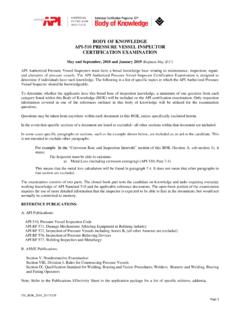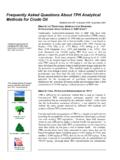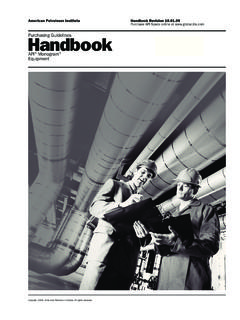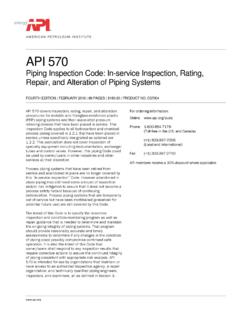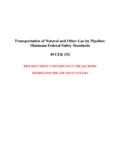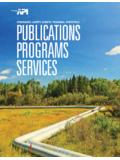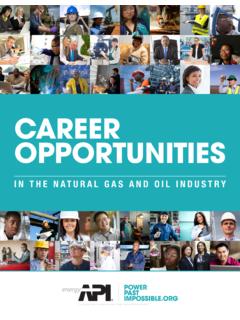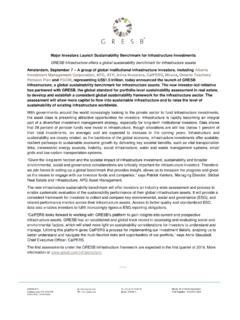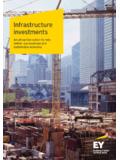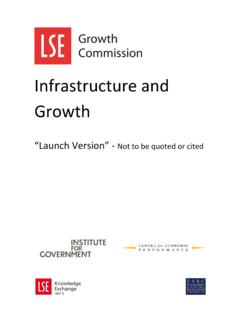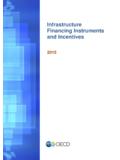Transcription of U.S. OIL AND GAS INFRASTRUCTURE INVESTMENT
1 OIL AND GAS INFRASTRUCTURE INVESTMENTTHROUGH 2035 AN ENGINE FOR ECONOMIC GROWTHSTUDY PREPARED FOR AMERICAN PETROLEUM INSTITUTE Copyright 2017 American Petroleum Institute (API), all rights reserved. Digital Media | DM2017-036 | PDFAPRIL 2017 ICF Authors: Kevin Petak, Harry Vidas, Julio Manik, Srirama Palagummi, Anthony Ciatto, and Andrew Griffith About API: The American Petroleum Institute (API) is the only national trade association that represents all aspects of America s oil and natural gas industry. Our more than 625 corporate members, from the largest major oil company to the smallest of independents, come from all segments of the industry. They are producers, refiners, suppliers, marketers, pipeline operators and marine transporters, as well as service and supply companies that support all segments of the industry.
2 Although our focus is primarily domestic, in recent years our work has expanded to include a growing international dimension, and today API is recognized around the world for its broad range of programs. About ICF: ICF (NASDAQ:ICFI) provides professional services and technology solutions that deliver beneficial impact in areas critical to the world's future. The firm combines passion for its work with industry expertise and innovative analytics to produce compelling results throughout the entire program lifecycle, from research and analysis through implementation and improvement. Since 1969, ICF has been serving government at all levels, major corporations, and multilateral institutions. More than 5,000 employees serve these clients from more than 65 offices worldwide Waivers.
3 Those viewing this Material hereby waive any claim at any time, whether now or in the future, against ICF, its officers, directors, employees or agents arising out of or in connection with this Material. In no event whatsoever shall ICF, its officers, directors, employees, or agents be liable to those viewing this Material. Warranties and Representations. ICF endeavors to provide information and projections consistent with standard practices in a professional manner. ICF MAKES NO WARRANTIES, HOWEVER, EXPRESS OR IMPLIED (INCLUDING WITHOUT LIMITATION ANY WARRANTIES OR MERCHANTABILITY OR FITNESS FOR A PARTICULAR PURPOSE), AS TO THIS MATERIAL. Specifically but without limitation, ICF makes no warranty or guarantee regarding the accuracy of any forecasts, estimates, or analyses, or that such work products will be accepted by any legal or regulatory body.
4 Contacts: American Petroleum Institute ICF Steven Crookshank, Senior Economist Kevin Petak, Vice President 1220 L Street, NW 9300 Lee Highway Washington, DC 20005 Fairfax, VA 22031 Table of Contents Executive Summary .. 1 1 Introduction .. 6 Study Objectives .. 6 Study 8 INFRASTRUCTURE Coverage .. 9 Report Structure .. 10 2 Methodology .. 12 Modeling Framework .. 12 INFRASTRUCTURE Methodology and Criteria .. 13 3 Scenario Overview .. 23 Defining the Study s Scenarios .. 23 Comparison of Supply, Demand, and Pipeline Capacity in the Scenarios .. 27 4 Oil and Gas INFRASTRUCTURE Requirements .. 42 Overview of Oil and Gas INFRASTRUCTURE Development .. 42 Oil and Gas INFRASTRUCTURE Development by Category.
5 45 Summary of Regional INVESTMENT in Oil and Gas INFRASTRUCTURE .. 59 5 Results of the Economic Impact Analysis .. 64 6 Conclusions .. 70 Appendix A: ICF Modeling Tools .. 74 Gas Market Model (GMM) .. 74 Detailed Production Report (DPR) .. 77 NGL Transport Model (NGLTM) .. 79 Crude Oil Transport Model (COTM) .. 81 Appendix B: Details for INFRASTRUCTURE Development .. 83 New INFRASTRUCTURE and E/U/R/R .. 83 New INFRASTRUCTURE .. 101 Enhancement, Upgrade, Replacement, and Refurbishment (E/U/R/R) .. 119 Appendix C: Regional Capital Expenditures for INFRASTRUCTURE Development .. 137 Appendix D: Average Annual Values for Gross State Product and 151 Appendix E: Approximate Economic Impacts of Pipeline and Gathering CAPEX .. 153 1 Executive Summary During the past five years, oil and gas INFRASTRUCTURE development proceeded at a rapid pace, and many have wondered whether the trend can continue.
6 In that light, API contracted ICF to undertake a study that investigates the amount of oil and gas INFRASTRUCTURE development possible in the through 2035. This report summarizes results of the study. The report focuses on the amount of INFRASTRUCTURE needed for two different scenarios, a Base Case and a High Case, each of which are plausible depictions of future market conditions. While the Base Case represents a most likely scenario, the High Case is put forward to assess INFRASTRUCTURE development in a more robust environment that is fostered by a larger hydrocarbon resource base and more rapid advancements in E&P technology. The study assesses capital expenditures associated with and the resulting economic consequences of oil and gas INFRASTRUCTURE development.
7 Key findings are as follows: 1) Rapid INFRASTRUCTURE development is likely to continue for a prolonged period of time. The primary drivers for robust development are still in place shale and tight resource development is likely to continue in earnest, and markets will grow in response to the relatively low commodity prices that are being fostered by new oil and gas supplies. 2) Total capital expenditures (CAPEX) for oil and gas INFRASTRUCTURE development will range from $ to $ trillion from 2017 through 2035 (Exhibit ES-1). These levels of INVESTMENT equate to an average annual CAPEX ranging from $56 to $71 billion throughout the projection (Exhibit ES-2). This includes investments in new as well as existing INFRASTRUCTURE for the following categories: a) Surface and Lease Equipment; b) Gathering and Processing Facilities; c) Oil, Gas, and NGL Pipelines; d) Oil and Gas Storage Facilities; e) Refineries and Oil Products Pipelines; and f) Export Terminals.
8 Exhibit ES-1: Projected Capital INVESTMENT in Oil and Gas INFRASTRUCTURE from 2017-2035 (Million 2015$) Gas$480,70745%NGL$57,1086%Oil$521,87149% Base CaseTotal INVESTMENT = $1,059,686 High CaseTotal INVESTMENT = $1,342,167 Gas$651,12849%NGL$84,8106%Oil$606,22945% 2 3) INVESTMENT in INFRASTRUCTURE contributes $ to $ trillion to Gross Domestic Product (GDP) over the projection period, or between $79 and $100 billion annually. 4) INFRASTRUCTURE development will employ an average of 828,000 to 1,047,000 individuals annually in the Significant jobs are created not only within states where INFRASTRUCTURE development occurs, but across ALL states because of indirect and induced labor impacts. Oil and gas INFRASTRUCTURE development has far-reaching benefits across the entire economy.
9 5) The outcome of the scenarios is dependent on regulatory approvals of INFRASTRUCTURE projects. Exhibit ES-2: Oil and Gas INFRASTRUCTURE CAPEX by Year (Million 2015$) Base CaseProjected (2017-2035) Average Annual CAPEX = $55,773 High CaseProjected (2017-2035) Average Annual CAPEX = $70,640$0$10,000$20,000$30,000$40,000$50 ,000$60,000$70,000$80,000$90,000$100,000 2012201320142015201620172018201920202021 2022202320242025202620272028202920302031 2032203320342035 NewE/U/R/RE/U/R/R = Enhancement/Upgrade/Replacement/Refurbis hment$0$10,000$20,000$30,000$40,000$50,0 00$60,000$70,000$80,000$90,000$100,00020 1220132014201520162017201820192020202120 2220232024202520262027202820292030203120 32203320342035 NewE/U/R/RE/U/R/R = Enhancement/Upgrade/Replacement/Refurbis hment 3 Study Highlights The scenarios in this study project significant growth in oil and gas production and markets that evolve to accommodate such growth.
10 While the Base Case shows fairly constant oil production in aggregate, tight oil supplies will continue to grow to offset declines in conventional production. In the High Case, oil production growth is robust with production rising to upwards of 12 million barrels per day by 2035. Natural gas production growth is even more pronounced, increasing from roughly 72 billion cubic feet per day at present to between 110 and 131 billion cubic feet per day by 2035. Natural gas liquids (NGL) will track along with gas production over time. Such robust production growth is supported by strong demand growth. Refinery output in the will increase from its present level of just over 16 million barrels per day to between 17 and 19 million barrels per day by 2035.

